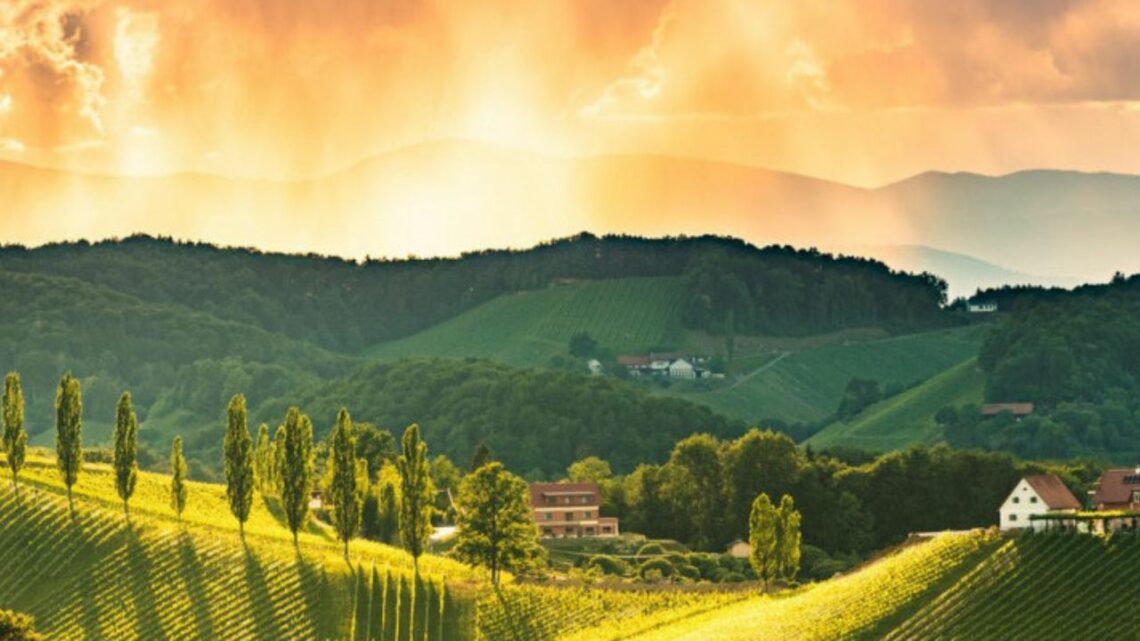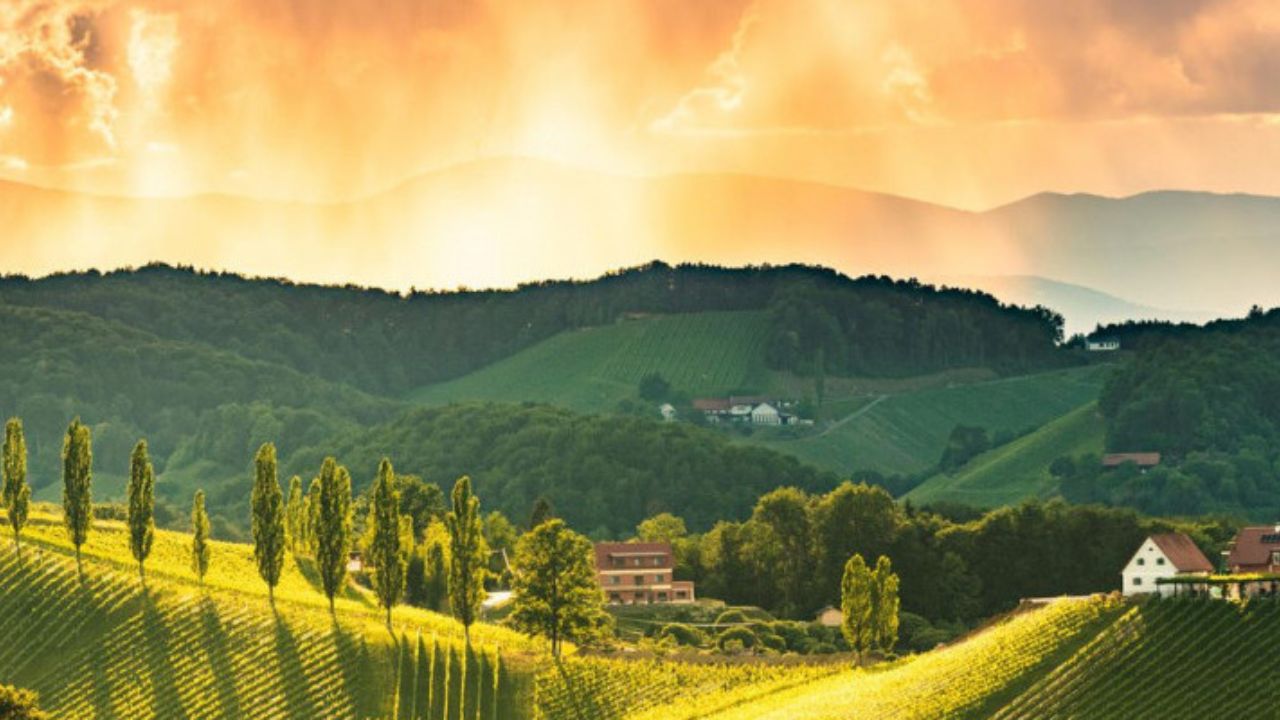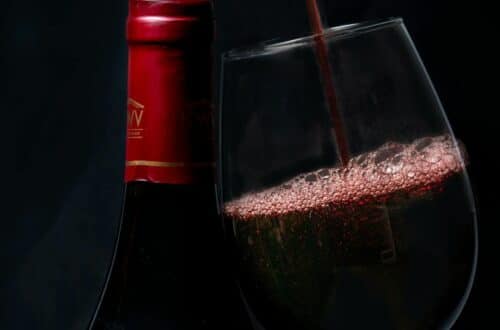
Südsteiermark wines
Steiermark, also referred to as Styria, is an enchanting wine region in Austria, featuring three separate wine zones: Vulkanland, Weststeiermark, and Südsteiermark.
Steiermark has a long and illustrious viticulture heritage that goes back to ancient times.
In 2018, all three wine zones achieved the DAC designation, establishing the characteristic white wines and emphasizing the significance of indigenous grape varieties.
Forget stuffy old wineries – Südsteiermark, tucked away in Austria’s gorgeous Styria region, is all about fresh energy and exciting wines. Young, passionate winemakers are taking the reins here, crafting bottles that burst with flavor. The secret sauce? Südsteiermark’s got it all – diverse soils from volcanic rock to limestone, hot days that give way to cool nights, and a climate that coaxes out the best in grapes. Speaking of grapes, Sauvignon Blanc is king here, but you’ll also find delicious Welschriesling and Pinot Blanc. Want a guarantee of quality? Look for the Südsteiermark DAC label – it means you’re getting a top-notch bottle.
Südsteiermark overall presentation
Winemakers in Südsteiermark are often young people who have traveled a lot and learned through their travels, although I guess the local school in Silberberg also largely contributed.
Regardless of the season, this region is worth a visit, especially during an autumn wine tour along the wine route, both along the Slovenian border and through the Sausal region west of the city of Leibnitz.
Other places worth visiting are Ehrenhausen, Gamlitz, Leutschach, or Kitzeck.
Contrary to what we are used to in Austria, many vineyards are situated on plots where the winery is itself implanted. So it’s difficult to speak about specific vineyards because each winery has its own vineyard…sort of
Terroir of Südsteiermark : soil and climate
Despite its relatively small size (2560ha), the region has a remarkable diversity of soils, including volcanic and schist soils, gravelly terrains, sandy soils washed down from the Alps, and occasional patches of limestone.

The climate here exhibits a wide diurnal temperature range, a fancy word for hot summer days and refreshingly cool summer nights. This helps the development of rich aromas. This mild and humid Mediterranean climate influences the long vegetation period.
Grape varieties in Südsteiermark
The vineyards in this region focus mainly on white grape varieties, especially Sauvignon Blanc.
Alongside Welschriesling, Pinot Blanc, Morillon (Chardonnay), Pinot Gris, Riesling, Muscat Blanc à Petits Grains, and Traminer, Sauvignon Blanc forms the basis of Südsteiermark DAC wines.
Südsteiermark DAC
Today, the Sauvignon Blancs from southern Styria are internationally renowned wines. It is therefore not surprising that this grape variety tops the list of authorized DAC varieties.
The Südsteiermark DAC, established in 2018 also allows for the production of wines using a variety of grape varieties, including Welschriesling, Pinot Blanc, Chardonnay (Morillon), Pinot Gris, Riesling, Muscats Blancs à Petits Grains, Sauvignon Blanc, Traminer, and their blends.
The region follows a three-tier system with Gebietswein representing the broader regional expression, Ortswein designating wines from specific localities, and Riedenwein representing wines from specific vineyard sites.
For Ortswein, the authorized grapes vary on the region :
- Kitzeck-Sausal: Sauvignon Blanc, Riesling
- Eichberg: Sauvignon Blanc, Gelber Muskateller
- Leutschach: Sauvignon Blanc, Gelber Muskateller
- Gamlitz: Sauvignon Blanc, Gelber Muskateller
- Ehrenhausen: Sauvignon Blanc, Morillon
You may also come across young wines known as “Junker,” which announce the new vintage.
Wineries in Südsteiermark
Now to the wineries! I you want more addresses, I highly recommend Stephen Brook’s book, which you can easily find on Amazon.
Georgiberg is renowned for producing sound wines with a clean and fruity character, particularly from the vineyard “Wielitsch.” Gross, operated by the two sons of Alois Gross, Johannes and Michael, stands out with its prized site, Nussberg. Their winemaking approach is rooted in tradition, with fermentation taking place in temperature-controlled steel tanks using mostly natural yeasts. The top wines from Gross are aged in large casks.
Jaunegg, a rising star in the region, took over the family domain in 2002 and is known for crafting dense and complex white wines. Their most important site is Knily. Lackner-Tinnacher has been practicing organic farming since 2012, and the majority of their wines are sourced from single vineyards and aged in large casks. Their vineyards include Steinbach with light, sandy, and gravelly soil, Eckberg with marl and limestone, Welles with well-ventilated gravel and sandy soils, and Flamberg with pure limestone.
Lackner-Tinnacher‘s vinification process avoids botrytis, incorporates some skin influence but limited to 24 hours, and employs warm fermentation with natural yeasts, which can extend for up to 4 months. The wines are aged on fine lees without stirring, resulting in exceptional clarity and longevity.
Maitz predominantly ages their white wines in barrels but avoids excessive oak. Their two single-vineyard sites, Schusterberg and Hochstermetzberg, produce wines worth seeking out, with Schusterberg being more delicate and Hochstermetzberg showcasing a creamier profile.
Erwin Sabathi, operated by three brothers, Christophe, Gert, and Erwin, is a large organic estate that also leases an additional 60 vineyards. They produce exceptional Sauvignon Blanc, particularly the super Pössnitzberg Alten Reben, but their Chardonnay is equally impressive.
Sattlerhof focuses on Sauvignon Blanc, with two main sites, Sernauberg Pfarrweingarten with fossil limestone and loamy sands, and Kranachberg with gravel and sand. Skoff Original, a large estate practicing organic farming, cultivates 13 single vineyards and selectively harvests their grapes.
Their whites undergo maceration for up to 24 hours, resulting in perfumed and elegant wines like Morillon Grassnitzberg (Gelber Muskateller) and a range of Sauvignons. Obegg vineyard is particularly excellent, especially their Hochsulz wines.
Tement, one of Styria’s pioneering wineries, boasts 60% Sauvignon Blanc production. Their most famous vineyard is Zieregg, located on the Slovenian border, featuring mixed soils with loam, limestone, and blue clay. The Grassnitzberge vineyards have warm sandy loams over eroded limestone. Sauvignon Zieregg is their flagship wine, and Morillons are sourced from Ziereg, Sulz and Muschelkalk.
Conclusion : Südsteiermark wines
Südsteiermark, a picturesque wine region in Styria, Austria, is known for its young and knowledgeable winemakers.
The region offers a diverse range of soils, including volcanic, schist, gravel, sandy, and limestone, contributing to the unique terroir. The climate, with hot days and cool nights, allows for the development of rich aromas in the wines.
The vineyards mainly focus on white grape varieties, particularly Sauvignon Blanc, along with Welschriesling, Pinot Blanc, Chardonnay (Morillon), Pinot Gris, Riesling, Muscat Blanc à Petits Grains, and Traminer.
The Südsteiermark DAC, established in 2018, provides a three-tier system for wine classification, highlighting the regional (Gebietswein), specific localities (Ortswein), and vineyard sites (Riedenwein).
Several notable wineries such as Georgiberg, Gross, Jaunegg, Lackner-Tinnacher, Maitz, Erwin Sabathi, Sattlerhof, Skoff Original, and Tement, produce outstanding wines, particularly Sauvignon Blanc and Chardonnay.
As an Amazon associate I earn from qualifying purchases.







